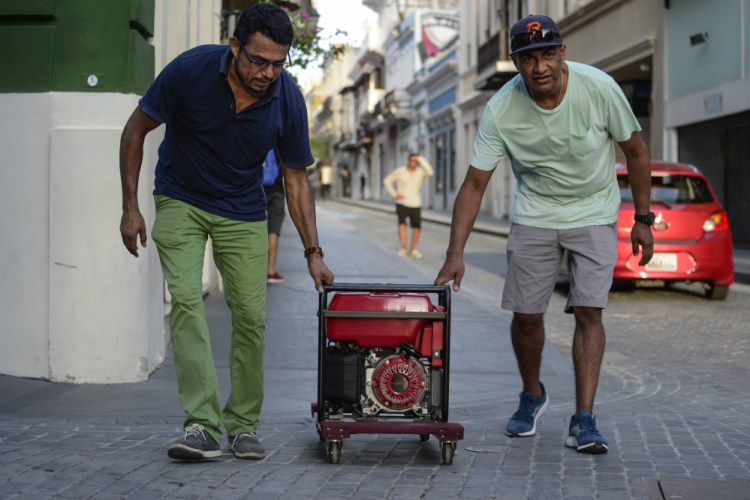SAN JUAN, Puerto Rico — The narrow blue cobblestone streets of Old San Juan are deserted. Cigar shops are boarded up. Boutiques in bright colonial buildings are closed.
“It’s like a ghost town,” said Mike Maione, a 57-year-old tourist from Flanders, New Jersey, who was staying in the heart of the colonial city with his wife at a small hotel powered by a generator. “We’ve been here a number of times before, and the place is usually just crawling with tourists, but there’s nobody here.”
Tourism, a rare thriving sector on the island in a deep economic slump, is practically nonexistent a month after Hurricane Maria swept though. And part of the recovery from the storm depends on how fast visitors reappear.
About a third of the hotels in Puerto Rico remain shuttered. Restaurants and shops are still without power. Beaches are closed for swimming because of possible water contamination.
The high season begins in December, and tourism officials are hoping to lure some visitors, but that depends on when power is fully restored and how quickly hotels and attractions can repair the catastrophic damage.
“We want Puerto Rico to be more like New Orleans post-Katrina and Detroit post-financial crisis,” said Jose Izquierdo, the executive director of Puerto Rico’s government Tourism Company . Though, he hopes, on a faster timeline.
The U.S. territory usually sees more than 5 million visitors a year, and they spend close to $4 billion, creating jobs for more than 80,000 people. While that’s a small portion of the overall economy, about 8 percent, money generated by visitors has been growing at the same time other sectors have shrunk during a 10-year recession.
Maria roared across the island on Sept. 20 as a Category 4 storm, killing more than 50 people and knocking out electricity to the whole island. More than a month later, only 30 percent of customers have power, though Gov. Ricardo Rossello has pledged to get that to 95 percent by Dec. 31. Roughly 70 percent of the communication network has been restored, and 70 percent of the water service is back.
The main airport recently resumed full operations. Cruise ships are beginning to sail again. The Bacardi rum distillery will reopen Nov. 1. Nearly all the island’s casinos are open. Old San Juan’s colonial-era buildings mostly survived intact.
“We don’t want to give up entirely on the high season,” said Izquierdo, who hopes business will be bolstered by Puerto Ricans coming home for the holidays, emergency federal officials working on the recovery and others helping to rebuild. .
But for Patti Weiss, 54, of Gilbertsville Pennsylvania, the uncertainty was too much. She and her husband planned their Royal Caribbean cruise a year ago and regularly embark from Puerto Rico, but are leaving from Florida instead.
“I just didn’t feel it was the right time to go, it was too iffy.,” she said.
Scores of restaurants are open, but operating under truncated hours with limited menus and many without power. Some are offering discounted meals to locals who can’t cook. Chef Ariel Rodriguez, owner of Ariel, a fine dining spot open for almost 30 years where a two-course meal is $54, said it’s been nearly impossible to get ingredients. He was offering a meal of beef stew and rice for $5. For smaller eateries, it’s hard to pay the cost of diesel for generators, said chef Maria Grubb. Her 52-seat restaurant is still closed.
“It’s quite crushing,” she said. “Rent is still due. Insurance is still due, distributors need to be paid. We have a staff of 14 people without any means of making money.”
The financial impact of Maria on the industry won’t be clear until after the season ends, but the visible impact is more obvious. Some of the island’s best-known attractions were battered, like El Yunque, a biologically diverse tropical rain forest. One of the island’s most famous resort hotels, El Conquistador in Fajardo, will be closed until the end of the year for repairs.
The expansive grounds of the Castillo San Felipe del Morro are open around the breathtaking 250-year-old Spanish fort overlooking San Juan Bay, but the fort itself is still shut. Beaches that were slammed by lashing rain and winds may also be contaminated after sewers overflowed; environmental officials say no one should go in yet.
Even if people do come, finding a hotel will be tricky. There are roughly 100 hotels open, mostly powered by generators, but nearly all are occupied with recovery workers and it’s not clear how long they’re staying, though tourism officials say they expect more rooms available starting Dec. 20.
Send questions/comments to the editors.


